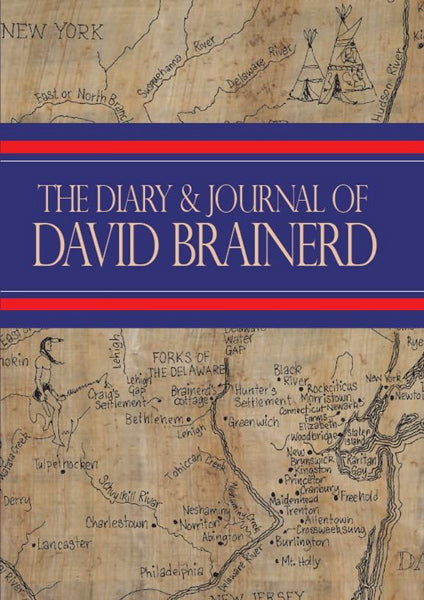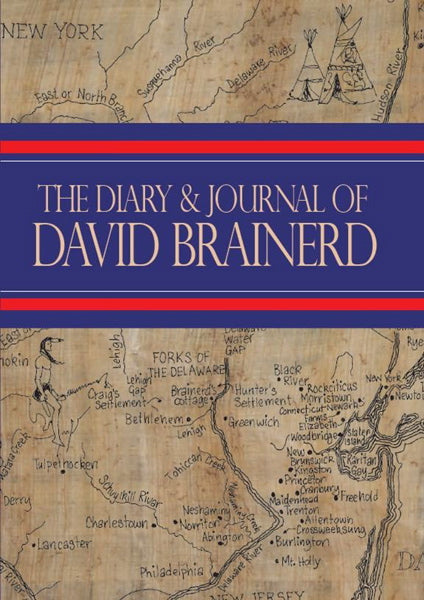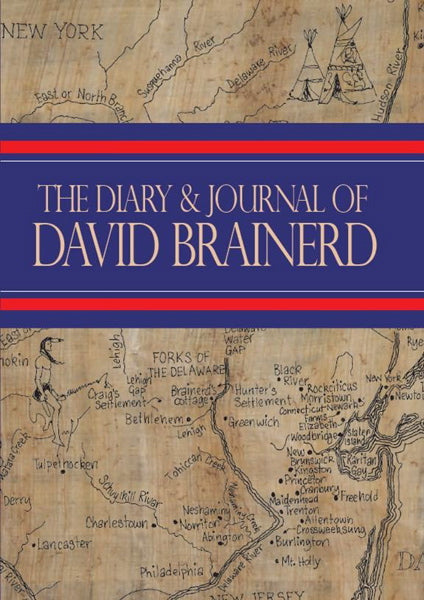The Diary and Journal of David Brainerd: Preface and Reflections by Jonathan Edwards
Edwards, Jonathan; Brainerd, David
Sign up to be the first to know when it's here
The Diary and Journal of David Brainerd is of much more than merely historical interest. The first internationally recognized biography ever to be published, it has had a profound impact on successive generations of Christians around the world. Few books have done so much to promote prayer and missionary action, and it is not without good reason that it has remained in print since the great New England pastor and theologian Jonathan Edwards first published it in 1749.
Between 1742 and his death in 1747 David Brainerd took the gospel to the North American Indians of New Jersey, Pennsylvania and Massachusetts. He willingly ran any risk and accepted any hardship to fulfill his calling as a missionary. The amount of work which he achieved in such unpromising and difficult circumstances now seems almost incredible. Moreover his total dedication to the cause of making Christ known inspired the finest of missionaries who followed in his footsteps.
-
Cover TypeHardcover
-
ISBN9780851519548
-
Page Count784
-
PublisherBanner of Truth
-
Publication DateJune 2007
Endorsements (3)
"Oh! blessed be the memory of that beloved saint! No uninspired writer ever did me so much good."
See AllHenry Martyn
"I was much humbled today by reading Brainerd. O, what a disparity betwixt me and him! He always constant; I as inconstant as the wind."
See AllWilliam Carey
"Brainerds life is a vivid, powerful testimony to the truth that God can and does use weak, sick, discouraged, beat-down, lonely, struggling saints, who cry to him day and night, to accomplish amazing things for his glory."
See AllJohn Piper
About the Author
David Brainerd, the great missionary to the North American Indians, was born in April, 1718 at Haddam, Connecticut. His father, a legislator in Connecticut, died when David was nine years old and his mother died when he was fourteen. He lived with a godly aunt and uncle until he was eighteen and then tried farming for a year at nearby Durham, CT. Though growing up in the local Congregational Church, Brainerd was converted at age twenty-one and then studied at nearby Yale College. He left after a few months with a recurring illness, returning one year later at the height of the evangelical revival at Yale under the preaching ministry of George Whitefield.
In somewhat intemperate zeal, Brainerd spoke in wonder at the Rector of Yale College not falling down dead for fining students for their evangelical zeal, and when he suggested that a tutor had no more grace than a chair, he was expelled from Yale, thus not completing his degree. The State of Connecticut required all ministers to graduate from Yale, Harvard, or a European university and Brainerd was thus denied ordination. He answered the call to become a missionary to American Indians under the auspices of the Scottish Society for Propagating Christian Knowledge.
Brainerd’s life was fraught with recurring illness, loneliness, and depression. If Jonathan Edwards was able to overcome his melancholy through walks in the woods, looking at the beauty of nature, this seemed not to work for Brainerd. In fact, nothing worked to remove his depression. Thankfully it did not result in suicidal thoughts, but it was nonetheless a terrible burden to him.
Brainerd served the Housatonic Indians near Stockbridge, MA and several tribes at the Forks of the Delaware River where hundreds were converted in a very brief time. After a year or so near Lebanon, CT with the Iroquois Indians, Brainerd began losing his battle with tuberculosis. He made his way to the home of Jonathan and Sarah Edwards in May, 1747, where he died on October 10.
Jonathan Edwards: Jonathan Edwards was born a little over seventy years after the first Puritan settlement of New England and, at the time of his birth, October 5, 1703, there were some 130 towns in the colony. Some were well established, others were small and on the frontiers of the wilderness. He spent his first twelve years in his parents’ home at East Windsor, close to the Connecticut river. His father, Timothy Edwards, was pastor of the local church, a good student and preacher, as well as a part-time school teacher and farmer. His mother, Esther, had eleven children—four girls, then Jonathan, to be followed by six more girls, and all of them six feet in height. Of the larger family circle, his maternal grandfather, Solomon Stoddard, was pastor of the largest church in New England, some thirty-five miles away at Northampton.
Jonathan Edwards would appear to have had a healthy and happy childhood, spent largely in female company. When he was not quite thirteen he was sent down river to the Collegiate School of Connecticut. Two years later the School settled at New Haven and became Yale College. The Head was one of Edwards’ many cousins, Elisha Williams. Edwards graduated Bachelor of Arts in 1720, and it was decided he would stay a further two years to become a Master of Arts. One year later, however, in the spring of 1721, something far more important happened.
Edwards at this time was already religious but despite ‘repeated resolutions’ it was not a religion that had changed his heart or humbled his natural pride. But now, he says, ‘I was brought to that new sense of things’, to an ‘inward, sweet delight in God and divine things . . . quite different from any thing I ever experienced before.’ ‘I began to have a new kind of apprehensions and ideas of Christ, and the work of redemption, and the glorious way of salvation by him.’
It was now that Edwards’ concern to see Christ’s kingdom extended was born. Before concluding his M.A. studies he went to serve First Presbyterian Church in New York at the age of nineteen. This was a joyful time for him and sermons he preached in New York show him to be remarkably mature. But there were those, including his father, who wanted him back in Connecticut and from 1724 to 1726 he joined the staff at Yale as a tutor. These were years of preparation and 1726 brought the great milestone of his life, for that year saw him invited to join his grandfather, Solomon Stoddard, now aged eighty-three, and still the minister at Northampton.
Meanwhile something even more significant had happened. As a teenager, Edwards had fallen in love with a girl who lived with her mother close to the College Green in New Haven. She was Sarah Pierrepont, and, on July 28, 1727, seventeen years old and dressed in pea-green satin brocade, she married Jonathan and became his inseparable helper.
Northampton, a town of some 200 homes, mostly clustered together for defence, had a population of about a thousand men, women and children. The couple set up home on a rural lane (later King Street), and were given ten acres and a further forty, five miles away. A year later the first of their children was born, and in the next twenty-two years the family grew until there were eight daughters and three sons.
The first seven years at Northampton were ones of hard work and happiness as Edwards settled into the habits of a lifetime. One concern, however, was to deepen as he grew to understand his congregation. His people made up the only church in the town and—according to the early New England pattern—the whole population regarded it as their own. When Stoddard died in 1729 the oversight fell entirely on Edwards.
The Northampton church was as eminent as any in the land but it seems that it had come to rely too much on what it had been. Its spiritual condition did not come up to Edwards’ expectation and his sermons increasingly revealed that he saw too many of his hearers as no more than nominal believers: ‘They come to meeting from one Sabbath to another and hear God’s word, but all that can be said to ’em won’t awaken ’em, won’t persuade ’em to take pains they may be saved.’ Often, he feared, such people were not even listening, ‘They are gazing about the assembly minding this and the other person that is in it, or they are thinking of their worldly business.’
This state of affairs came to an end in one of the best-known events of Edwards’ life, the revival of 1734–5, when, in his words, ‘A great and earnest concern about the great things of religion, and the eternal world, became universal in all parts of the town.’ He thought it probable that 300 had been converted within six months, and it was his hope that ‘the greater part of persons in this town, above sixteen years of age, are such as have the saving knowledge of Jesus Christ.’ These were months when the crowded meetinghouse was filled with praise.
Edwards wrote an account of the awakening which was published under the title, A Faithful Narrative of the Surprising Work of God. The book drew widespread attention and instantly put Edwards and the Northampton church on the world stage. This appears to have been the occasion of a family quarrel that was to go on through the rest of Edwards’ lifetime, particularly involving cousins on his mother’s side, the Williamses. The revival did not continue. It is clear that by 1736 Edwards was again struggling with the difficulties of more normal church life, and there was cause for some disappointment as his anticipations of the permanent results of the revival were not all fulfilled. Party strife, long endemic in the village, reappeared.
In 1740, however, a work of grace, much wider in scale than in 1734–5, began along the eastern seaboard. It was the beginning of ‘the Great Awakening’, which would touch several places in the thirteen colonies of the fledgling nation. For Edwards, the Great Awakening years were exhausting times which brought him ‘to the brink of the grave’. Besides the care of his own people, he was now itinerating widely to preach for other men. Correspondence multiplied, and yet somehow he was also preparing two of the most significant books ever written on the subject of revival, Distinguishing Marks of a Work of the Spirit of God, and Thoughts on the Revival in New England. Yet these were happy years, indeed, at one point, there was fear lest his wife Sarah would die of sheer joy!
The blessing of the early 1740s was followed by a longer period of difficulty when two major problems confronted Edwards almost simultaneously. First, in the wider scene in New England, opposition developed to the very idea of the Awakening as a ‘work of the Spirit of God’. Some, by foolish behaviour and lives lacking in Christlikeness gave just cause for criticism. Some of these people were fanatics, people who saw physical phenomena as sure proof of the Spirit’s work and presence. The ‘wild fire’ they represented gave support to the arguments of those who wished to discredit the whole work. In addition to this, in every revival there is a work of the Spirit on large numbers of individuals who express spiritual concern and their lives take on a new seriousness but it does not last, and in time there is a return to their former indifference and formal religion. With pain, Edwards had to recognize that in Northampton itself the number of true converts was not what he had once hoped.
The other great difficulty which Edwards now experienced was that support from his own congregation was weakening and one cause of this was the hostility of certain members of his wider family circle. During the 1740s Edwards had come to disagree with his grandfather Stoddard’s long-established practice of not requiring a profession of saving faith in Christ in order to be a communicant; communicants, Edwards came to see, ought to be believers. But Stoddard’s name was already a legend, and when his grandson’s disagreement with the great man became known there was uproar in the town, with the Williams family involved as usual. The final extraordinary outcome was his being voted out of his church. The great majority of the 230 male communicants voted for his removal. The tragedy deepens when Edwards writes that ‘most of them esteemed me to be the chief instrument in the hand of God of the eternal salvation of their souls’.
Thus one of the most fruitful pastorates in history ended on June 22, 1750. Edwards was now forty-six. No financial arrangement was offered to help them and for the best part of a year, apart from some temporary engagements, he remained unemployed. Then he accepted a call to an improbable situation. Stockbridge was a village in the frontier wilderness, forty miles from Northampton, and with a congregation of only about a dozen white families. One factor that added to the appeal of Stockbridge was the presence of Indians and the existence of a school for Indian children. So, after difficulties in selling their Northampton home, the whole family was eventually settled on the frontier by October 1751.
For Edwards Stockbridge was a haven of peace compared with the turmoil he had left behind. But it was not long before the family of Williamses at Stockbridge were showing all the prejudice and hostility that had marked the other members of the same clan. The Stockbridge Williamses had their own ambitious plans, in which material gain seems to have played no small part, and they wished for no oversight from anyone of Edwards’ stature. For three years there was to be another painful struggle, but this time the congregation stood with their pastor, and so did the Indians, whom the Williamses had antagonized. Only in 1754 did the Williamses in Stockbridge give up, and the strife was over.
Yet there were other trials, including persistent financial constraints, and, then, with the outbreak of war with the French, the whole frontier situation became exposed to attack. One of Edwards’ daughters, Esther, visited her parents and family at Stockbridge in the summer of 1756 and was filled with alarm at the danger of their situation.
The next year Esther’s husband, Aaron Burr, President of Nassau Hall, the College of New Jersey recently established at Princeton, died and Edwards was surprised to learn that the decision of the College trustees was that he should be his son-in-law’s successor. He did not wish to accept, and when the approaches to him continued, Edwards referred the decision to a council of friends. They concluded he should go to Princeton, the only time in his life that we read he shed tears. One major reason for his reluctance was that he now believed that he could be more useful by writing than by speaking and he had a number of potential books in hand. Given the urgency of the need at Princeton, Edwards left Sarah and most of his family behind at Stockbridge when he left in January 1758.
As he left the home for the last time, his daughter remembered, ‘When he had got out of doors he turned about,—“I commit you to God”, said he.’ Edwards was now fifty-four and he spoke of his health being stronger than previously, but the next month an inoculation against smallpox went wrong, and on March 22, 1758, he died at Princeton. Sixteen days after her father, Esther also died at Princeton, leaving two orphaned children. Sarah hurried down from Stockbridge to care for them, only to die herself and be buried with her husband at Princeton in October 1758.









